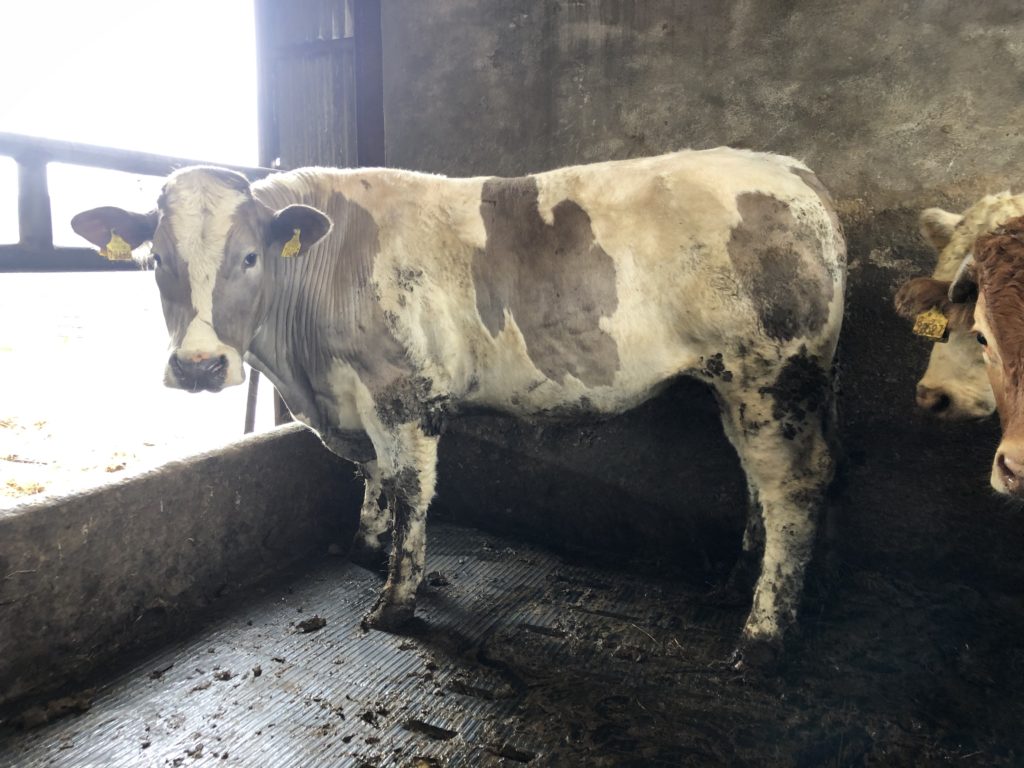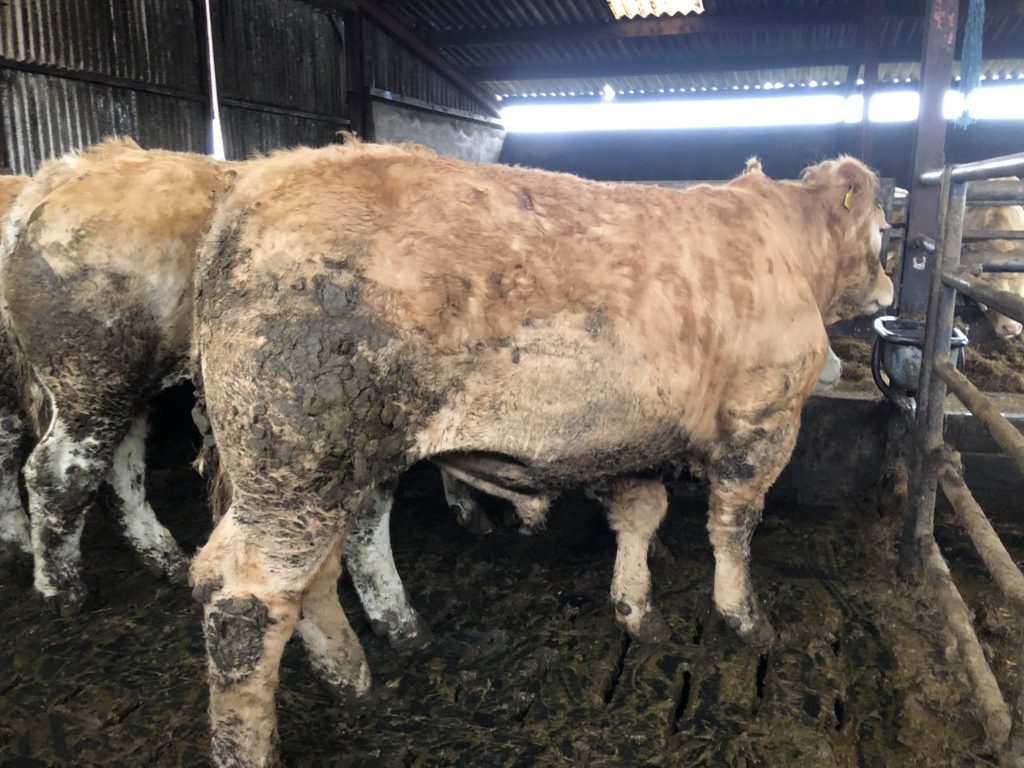On the outskirts of Headford, Tom Curran is a full-time farmer operating a store-to-beef system in Mausrevagh, Co. Galway, buying and finishing continental bullocks.
Tom buys in approximately 100 store bullocks annually, finishing continental bullocks both at grass during the summer, and houses the remaining steers for finishing over the winter period.
Agriland spoke with Tom about the current operation on the farm and got an insight into his approach to finishing these steers.

System of Production
Tom’s farm resides over 100ac and, as previously mentioned, he currently buys in store bullocks with the aim of killing them at 26-30 months of age. The target is not to allow the bullocks to pass the 30-month-old bracket.
The bullocks that are bought in are mainly R-grade steers, with some bullocks reaching a U-grade on occasion.
The ideal weights of stores bought in will vary between 540-600kg when purchased in the September/October, and 500-520kg bullocks being bought in the spring.
These are mainly bought at local marts based in Co. Galway such as Headford, Gort, Tuam and Athenry Marts, with a few purchases also coming from Ennis Mart in Co. Clare.
The breed preference is more towards Charolais and Limousin crosses, but there are some other continental breeds found throughout the mix of steers.
Speaking about other critera he looks for, Tom said:
“If they haven’t got a good structure and set of legs underneath them, I don’t want them. They need to be fit to carry their own weight comfortably.”
When it comes to the slaughter weight of the bullocks, this can range from deadweights of 420kg up to 470-480kg – which Tom admits are strong and heavy weights to have at slaughter.

Why finish bullocks?
With the other options of beef systems for the farm to diversify into, Tom explained why he decided to go down the route of solely finishing bullocks on the farm. He said:
“Like a lot of beef farmers we were finishing bulls on the farm a few years ago. Then in the spring of 2016, I found it hard to get bulls killed and I was buying in around 60 bulls at that time.
“When you compare the additional price on top of the base price that you can get for U+ grading bullock for example, there is the potential to get 44c/kg [higher grading price and quality assurance bonus] along with your base price, which isn’t available for bulls.

“So the more I thought about it, I had to make the decision to move more into finishing continental bullocks.
“I have switched to buying bullocks that are a little easier fleshed than other years, because I was finding that the more muscly type of bullocks were taking that bit longer to finish. Now a consequence of this is that I won’t have as many U-grades.
“We didn’t decide to buy in heifers because I think bullocks are easier handled. Heifers can be coming into heat and rising in the shed and may get hurt. Plus, I think the bullocks can get into bigger weights and their growth rates can be higher.”
Finishing diets and grazing
“Over the winter I’d be feeding the bullocks around 1kg of a beef nut to keep them warmed-up along with a silage-based diet,” Tom stated.
“If the bullocks are very ‘storey’ of themselves going out to grass, I find that it takes too long of a time to recover their weight gain.”

Currently there are 20 of the lighter bullocks out at grass, with Tom commenting that land conditions are holding up considerably well, keeping in mind the levels of rainfall that fell in recent weeks.
The farm also works off a strip grazing system, with Tom stating the paddocks on the farm are an ideal size to shorten down. The farm got a cover of half a bag of conventional urea (23 units) to the acre.

When finishing cattle off grass later in the summer, Tom said:
“I won’t push the bullocks too hard with meal once I let them out. I let the grass do all the work in putting on additional kgs of live weight. I may give them eight weeks of feeding prior to slaughter to drive them on.
“I will start feeding them in early May with 3kg of a beef nut and the more easier-fleshed bullocks will finish off of this level of meal.
“The more harder-fleshed bullocks will obviously take that bit more time and an additional few kgs to get them across the line.”
Finishers need contracts
When speaking with Tom, like a lot of finishers this winter, it was clear to see the frustration caused by the recent beef price drop experienced back in early February. He exclaimed:
“Farmers need contracts to know what they are facing into when feeding bullocks and heifers and killing them over the winter.
“The last two years, the factories have pulled the price for cattle. Last year they may have had some excuse, with Brexit and Covid-19, but this year there was no reason that I can seen why they pulled the price back in early February.

“I certainly won’t be feeding cattle for finishing out of the shed again; it just doesn’t make sense. There is a totally different cost of killing cattle in September and killing cattle in April.
“I think it’s a race to the bottom with beef finishing at the minute; there’s no guarantee of what we are going to be paid for our product.
“Factories will be getting some sort of contracts from the retailers – so why can’t beef farmers receive the same courtesy, especially for winter finishers?
“In my opinion, there is no future in beef farming for the likes of me; only that I have a passion for it, I would not be able to continue.
With the CAP [Common Agricultural Policy] payment reductions, which are planned, the profit margin from killing these cattle is just too small and we need that payment support.”

He added: “Like a number of beef farmers, I am relying a lot on my CAP payments. The reason I can stay at what I am doing, is that my old CAP payments that I received back in 2001-2002 were strong because I was still finishing a lot of cattle back then.
“Now with the new suggestions of reduced flat rate payments being based around the number of hectares farmed, it is going to leave me with one third of the payment that I started off with.
“Then with the EU allowing Mercosur beef into Europe which is not even held to the same standards that we have to follow, I mean this is seriously damaging to the value of our beef.
“The cost of producing these animals is going up, such as the prices for fertiliser, meal, diesel, etc., and yet the income is dropping for finishers.”

Difficulty caused by BEAM
Due to health reasons back in 2018, the farm had to reduce finishing continental bullocks for a year, with his wife Ann and family members assisting in the running of the farm until Tom was fit to be back in action.
He signed up last year for the Beef Emergency Aid Measure (BEAM) scheme. In terms of the reference period for the reduction of livestock manure nitrogen by 5%, it has left Tom in a challenging position to increase stock numbers.
He explained:
“Beef prices had dropped at the time [of signing up to BEAM] and we needed the support payment. I knew about the 5% reduction and I knew that I was going to have a problem because of my lower herd numbers back in 2018 and 2019.
“Funds were low on the farm and I had too much to lose at the time by not joining the scheme.
“I may sign up to the extension period just in case we do not meet the reduction requirement by the end of June – but I am certainly going to try and get finished as soon as possible.

“I was going to change my system and focus on buying more store bullocks for the summer grazing and less for the winter, but the BEAM scheme has stopped me doing that.
“I would have loved to have gone up to 120 cattle this spring and then keep less for the winter.
“The rule of the 5% reduction was a disaster really. It makes no sense because it’s only for one year. If there was a requirement over a five year period to reduce your carbon footprint well then fair enough it may make sense, but not to only have a requirement for one year.
“What is there stopping the farmers from increasing stock numbers straight away once they are finished in the scheme?”

Future plans
Speaking about the future plans for the farm, as Tom previously mentioned, the aim is to focus more on finishing continental bullocks at grass in the summer time.
Meanwhile in terms of succession, he said:
“It’s only me that is really working here on the farm but my family will always give me a hand whenever I need it and they are great.
“My sons and daughter all have jobs elsewhere and they are receiving steady incomes. I wouldn’t want them to be full-time farming at the minute because, in comparison, there isn’t the same margin/income for them from beef farming unfortunately,” Tom concluded.



